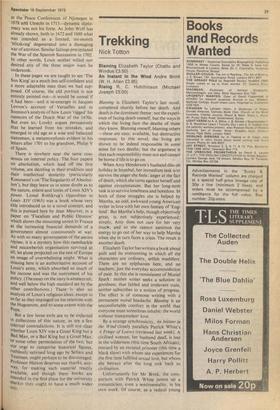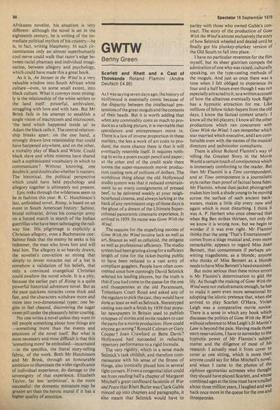Trekking
Nick Totton
Blaming Elizabeth Taylor (Chatto and Windus £3.50) An Instant in the Wind Andre Brink (W. H. Allen £3.95) Rising R. C. Hutchinson (Michael Joseph £5.00) Blaming is Elizabeth Taylor's last novel, completed shortly before her death. And death is the dominant theme: not the experience of facing death oneself, but the ways in which the living face the deaths of those they know. Blaming oneself, blaming others --these are easy, available, but destructive responses. In this novel, the living are shown to be indeed responsible in some sense for two deaths; but the argument is that such responsibility must not and cannot be borne if life is to go on.
When Amy Henderson's husband dies on holiday in Istanbul, her immediate task is to survive the anger she feels: anger at the fact of death, which she turns against herself and against circumstances. But her long-term task is to survive loneliness and boredom. In both of these struggles she is helped by Martha, an odd, awkward young American writer in love with her own fantasy of 'England'. But Martha's help, though objectively great, is not subjectively experienced: simply, Amy does not care for her very much; and so she cannot summon the energy to go out of her way to help Martha when she in turn faces a crisis. The result is another death.
Elizabeth Taylor has written a book about guilt and its overcoming in which all the characters are ordinary, selfish muddlers. There are no epiphanies here, and no teachers; just the everyday accommodation of pain. In this she is reminiscent of Muriel Spark : neither writer seeks a solution in goodness, that fabled and irrelevant state, neither subscribes to a notion of progress. The effect is of someone writing with a permanent moral headache. Blaming is an uncomfortable comfort in the world that everyone must sometimes inhabit the world without transcendent love.
By a strange synchronicity, An Instant in the Wind closely parallels Patrick White's A Fringe of Leaves (reviewed last week). A civilised woman, her husband dead, is lost in the wilderness (this time South African); rescued by an escaped prisoner (this time a black slave) with whom she experiences for the first time fulfilled sexual love, but whom she betrays after the long trek back to civilisation.
Unfortunately for Mr Brink, the comparison with Patrick White points up a romanticism, even a sentimentality, in his own work. Of course, as a radical young Afrikaans novelist, his situation is very different : although the novel is set in the eighteenth century, he is writing of the immediate political mythos of his country—he is, in fact, writing blasphemy. In such circumstances only an almost superhumanly cool nerve could walk that razor's edge between racial phantasy and individual imagination, between allegory and psychology, which could have made this a great book.
As it is, An Instant in the Wind is a very valuable window into South African white culture—even, to some small extent, into black culture. What it conveys most strongly is the relationship of the white settlers to the land itself: powerful, ambivalent, struggling with love and with hate. But Mr Brink fails in his attempt to establish a single vision of macrocosm and microcosm, 'the land which happened inside us' as Adam the black calls it. The central relationship breaks apart : on the one hand, a strongly drawn love relationship that could have happened anywhere, and on the other, a morality play of Black and White. Could black slave and white mistress have shared such a sophisticated vocabulary in which to communicate? Without knowing, one doubts it ;and doubts also whether it matters. The historical, the political perspective which could have held psychology and allegory together is ultimately not present.
Epic treks through the wilderness seem to be in fashion this year. R. C. Hutchinson's last, unfinished novel, Rising, is based on an event in South American history : Sabino, brutal militarist, drives his conscript army on a forced march in search of the Indian guerrillas who have been sabotaging the railway line. His pilgrimage is explicitly a Christian allegory, even a Buchmanite one: Sabino finds that the enemy he seeks is his redeemer, the man who loves him and will heal him. The allegory is so heavily drawn, the novelist's conviction so strong that simply to invent miracles out of a hat is somehow a validation of his beliefs, that only a convinced evangelical Christian could swallow the novel whole. It is a pity, because the earlier part of Rising is a quite powerful historical adventure novel. But as the pace quickens miracles come thick and fast, and the characters withdraw more and more into two-dimensional types: one begins to feel cheated, discovering the sugar sweet pill under the pleasantly bitter coating.
No one writes a novel unless they want to tell people something about how things are —something more than the events and emotions of the novel itself. But what is most necessary and most difficult is that this 'something more' be embodied—incarnated —in the specifics, the literal story-telling fabric, of the work. Both Mr Hutchinson and Mr Brink, through an honourable ambition to illuminate the wider significance of individual experience, do damage to the sovereignty of that experience. Elizabeth Taylor, far less 'ambitious', is the more successful : the domestic miniature may be greater art than the heroic mural if it has a higher quality of attention.






































 Previous page
Previous page